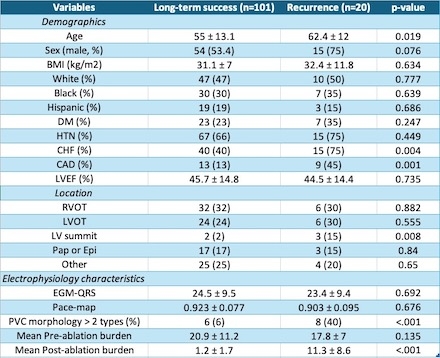Final ID: Sa2058
Time Course and Predictors of PVC Recurrence After Acutely Successful Catheter Ablation
Abstract Body (Do not enter title and authors here): Introduction
In prior studies, predictors of long-term success following acutely successful radiofrequency (RF) ablation have included female-sex, single-PVC morphology and EGM-QRS > 24ms. Time course and predictors of PVC recurrence following acutely successful ablation has been less well documented. Use of extended ambulatory monitoring in the immediate post-procedural period can help to identify those with early recurrence.
Goals
To define time to recurrence and predictors of recurrence of PVCs after RF ablation following acutely successful ablation.
Methods
Consecutive patients from January 1st, 2016 through December 31st, 2023 undergoing PVC ablation with available post-ablation extended ambulatory monitoring (Zio, iRhythm, San Francisco, CA) were retrospectively analyzed. Recurrence was defined as an increase in PVC burden to >5% during monitoring after acute success or failure to have sustained reduction in PVC burden of >80%. Acute success was defined as elimination of the targeted PVC after the last ablation lesion. Long-term succes was defined as absence of targeted PVC's during all follow-up visits and PVC-burden < 5% on follow-up monitoring.
Results
Among 121 patients who underwent successful PVC ablation, 101 (83.4%) had long-term success and 20 (17%) had recurrence. Patients with recurrence were older (62.4 ± 12 vs 55 ± 13., p = 0.019), had a higher incidence of CAD (13 (13%) vs 9 (45%), p = 0.001) and CHF (40 (40%) vs 15 (75%), p = 0.004). At time of ablation, the recurrence group was also more likely to have >1 PVC morphology (6 (6%) vs 8 (40%), p = <0.001). Location and earliest activation time of the predominant PVC were not assocated with likelihood of recurrence. Within the recurrence group, 13 (65%) had recurrence in the immediate 2 week post-procedural period with an average time to recurrence of 3.9 days.
Conclusion
Recurrence occured in slightly less than 20% of cases with a relatively high proportion of those occuring within the immediate 2 week post-procedural period during extended ambulatory monitoring. The presence of greater than 1 PVC morphology at time of ablation is a risk factor for recurrence suggesting a higher likelihood of acute suppression without durable resolution in those instances.
In prior studies, predictors of long-term success following acutely successful radiofrequency (RF) ablation have included female-sex, single-PVC morphology and EGM-QRS > 24ms. Time course and predictors of PVC recurrence following acutely successful ablation has been less well documented. Use of extended ambulatory monitoring in the immediate post-procedural period can help to identify those with early recurrence.
Goals
To define time to recurrence and predictors of recurrence of PVCs after RF ablation following acutely successful ablation.
Methods
Consecutive patients from January 1st, 2016 through December 31st, 2023 undergoing PVC ablation with available post-ablation extended ambulatory monitoring (Zio, iRhythm, San Francisco, CA) were retrospectively analyzed. Recurrence was defined as an increase in PVC burden to >5% during monitoring after acute success or failure to have sustained reduction in PVC burden of >80%. Acute success was defined as elimination of the targeted PVC after the last ablation lesion. Long-term succes was defined as absence of targeted PVC's during all follow-up visits and PVC-burden < 5% on follow-up monitoring.
Results
Among 121 patients who underwent successful PVC ablation, 101 (83.4%) had long-term success and 20 (17%) had recurrence. Patients with recurrence were older (62.4 ± 12 vs 55 ± 13., p = 0.019), had a higher incidence of CAD (13 (13%) vs 9 (45%), p = 0.001) and CHF (40 (40%) vs 15 (75%), p = 0.004). At time of ablation, the recurrence group was also more likely to have >1 PVC morphology (6 (6%) vs 8 (40%), p = <0.001). Location and earliest activation time of the predominant PVC were not assocated with likelihood of recurrence. Within the recurrence group, 13 (65%) had recurrence in the immediate 2 week post-procedural period with an average time to recurrence of 3.9 days.
Conclusion
Recurrence occured in slightly less than 20% of cases with a relatively high proportion of those occuring within the immediate 2 week post-procedural period during extended ambulatory monitoring. The presence of greater than 1 PVC morphology at time of ablation is a risk factor for recurrence suggesting a higher likelihood of acute suppression without durable resolution in those instances.
More abstracts on this topic:
4D Cardiac Optogenetics Enable Complex Arrhythmia Modelling and Precise Interventional Simulation
Wexler Yehuda, Grinstein Harel, Landesberg Michal, Glatstein Shany, Huber Irit, Arbel Gil, Gepstein Lior
Altering cardiac impulse propagation and generation by local flash photolysis of caged Ca2+Mochizuki Kentaro, Tamura Shoko, Morishita Yuma, Harada Yoshinori, Tanaka Hideo

